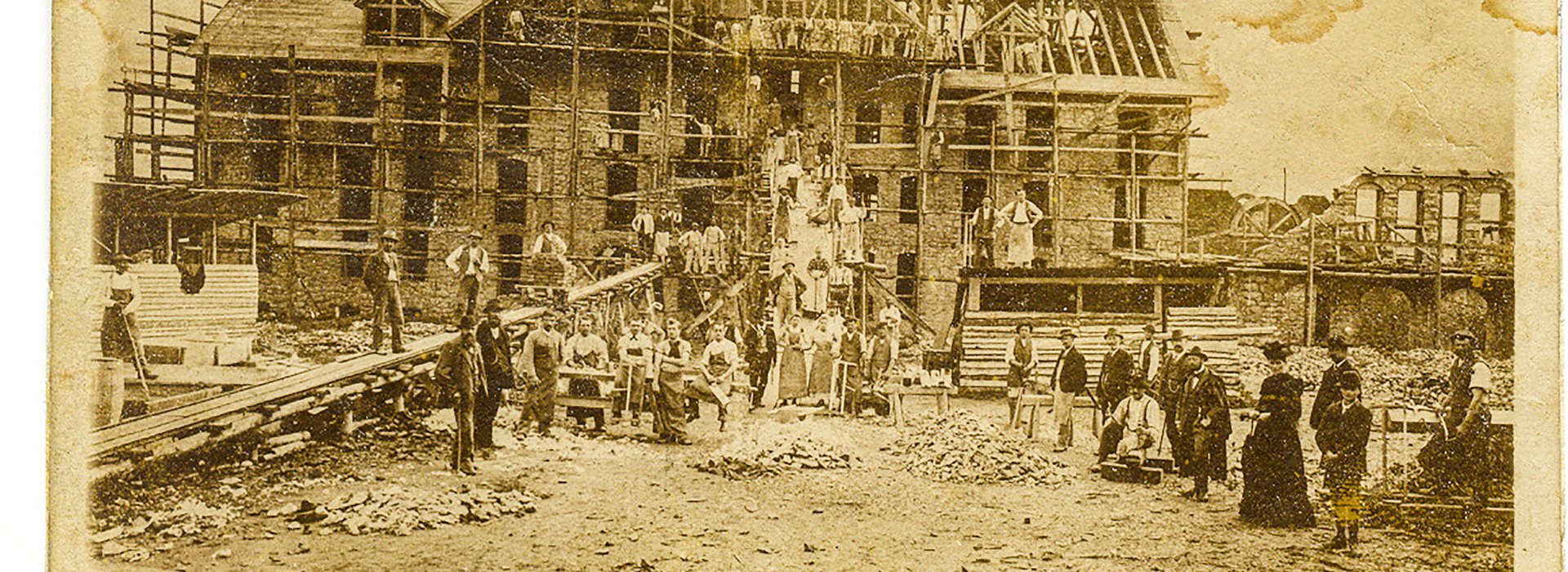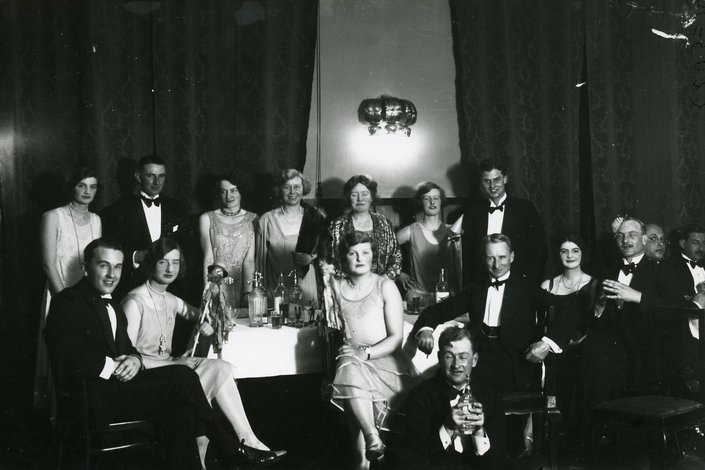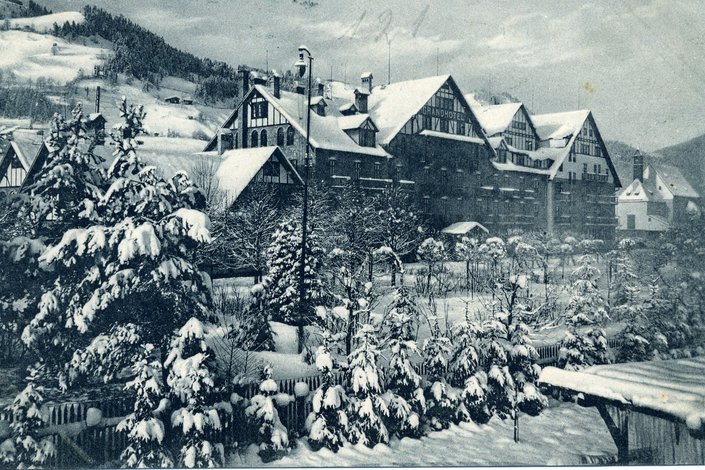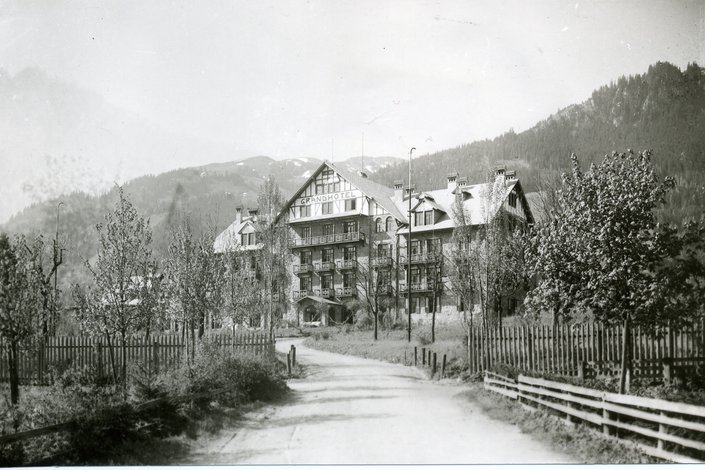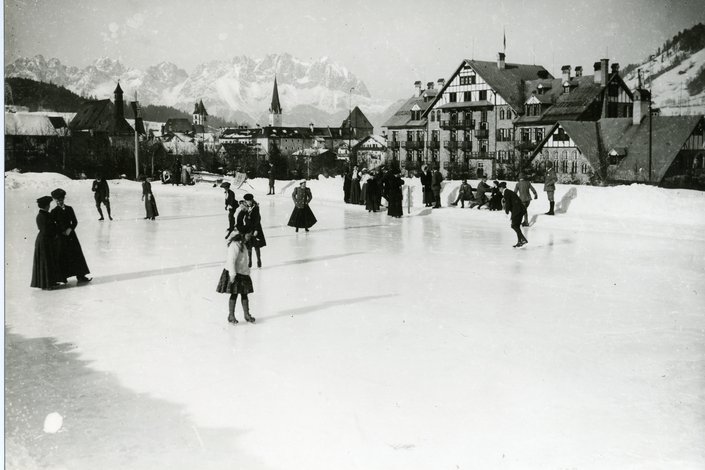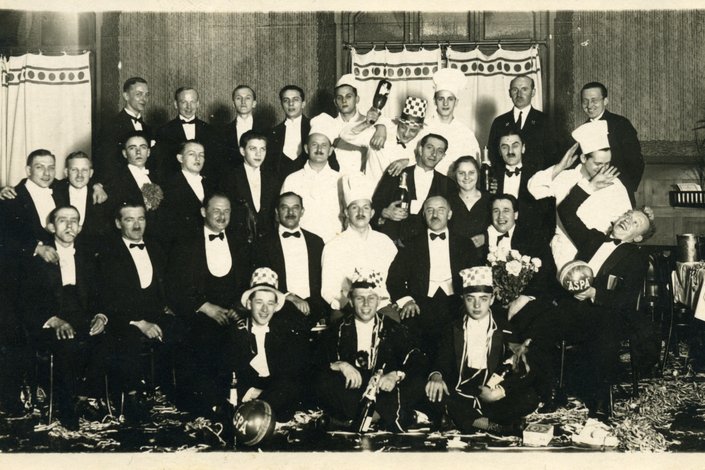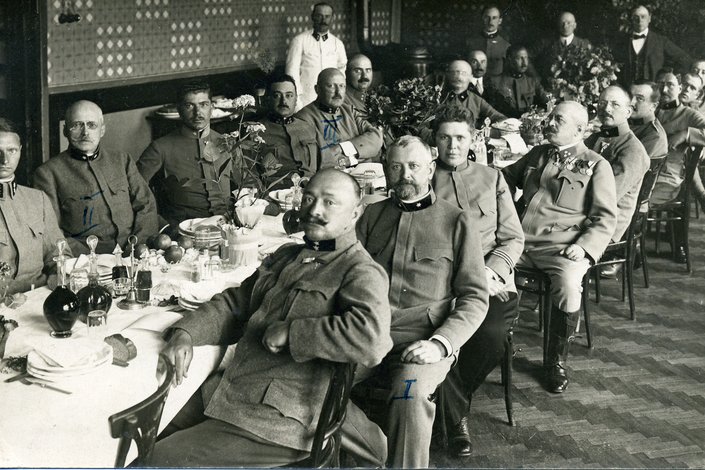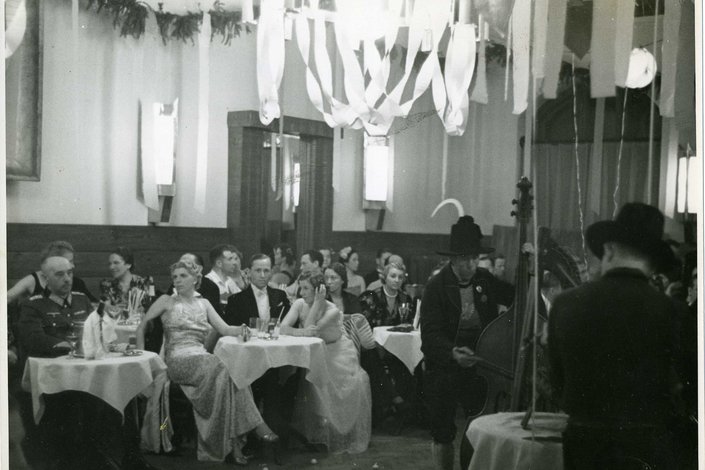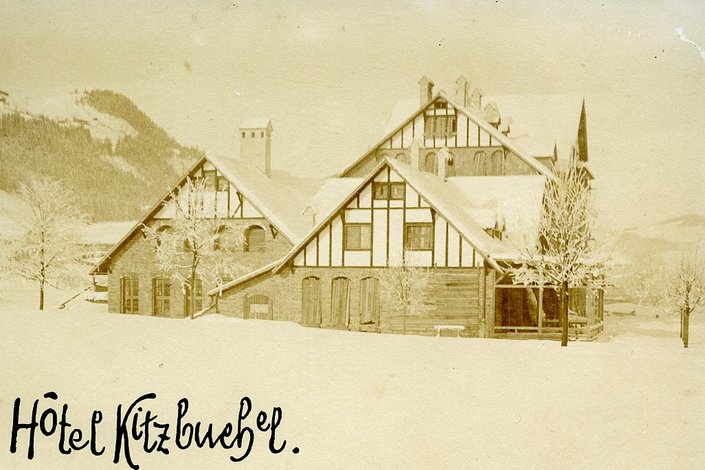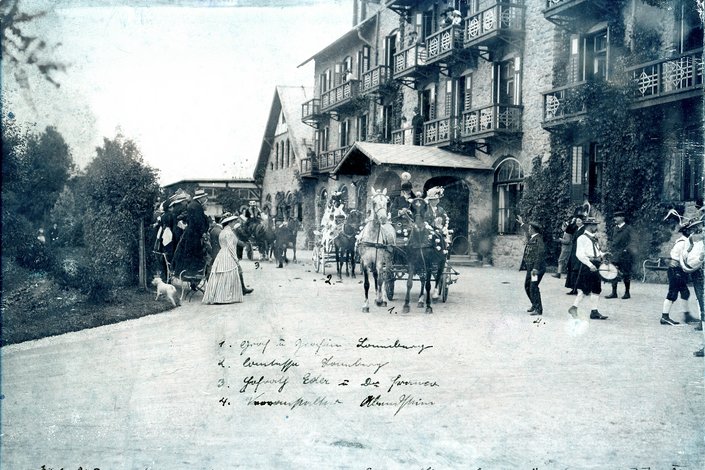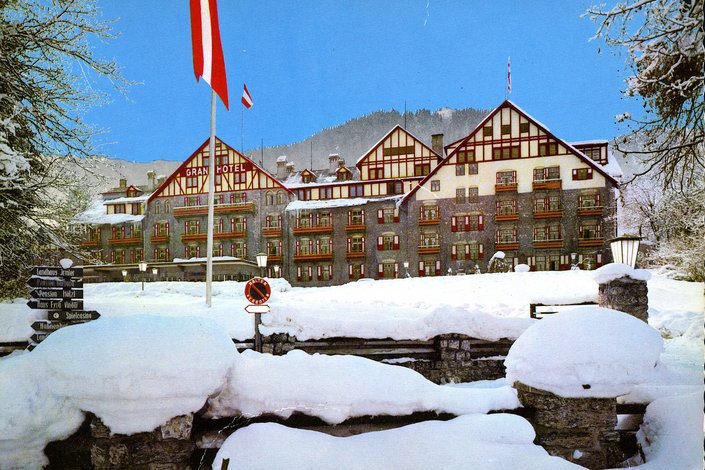The Grand Hotel narrates about opulence, decline, and rebirth
I want to emulate one of my dear guests. Just as Erich Kästner did in his lively books, I tell my story here. Unfortunately, it's not a tale for children. Too much has happened here. A lot of good, breathtakingly glamorous, but unfortunately also bad things. But now, read on and dive into my memoirs.
As always, my story begins with an idea. Franz Reisch, the father of the tourist resort Kitzbühel, had the vision of a representative hotel in the style of the buildings in Sulden and Karersee. And as it goes when you are passionately convinced, the right people come together. Six Kitzbühel gentlemen founded the Hotel Construction Association Kitzbühel on January 14, 1902.
With great enthusiasm, they engaged the architect Otto Schmid, who was himself the builder and co-owner of the Grand Hotel in Sulden. And imagine, in September 1902, the first photo of me was already taken: at the topping-out ceremony – surrounded by dignitaries of the town. It took less than a year to open. From July 12, 1903, I welcomed my first guests as Hôtel Kitzbühel – on a 43,000 m2 open plateau with a park and tennis courts, 80 rooms, central heating, baths, electric lighting in all rooms, an elevator, a large hall, a grand dining room, a beautiful restaurant with a veranda and garden, as well as a ladies' room, a music and reading room, a billiard room, and a photographic darkroom. Everything was truly delightful, and so Kitzbühel could enjoy over 1000 more guests compared to the best years before.
A noble residence for wealth and aristocracy
So, my story gained momentum. After a few years, I was renamed: "Grand Hotel" would be more fitting, according to the shareholders' consensus. I was made ready for winter, and Government Councillor Dr. Anton Kofler took over 25% of the shares and the management. A tremendous balancing act for the 53-year-old politician at the time, as he was, among other things, an Imperial Councillor representing the interests of North Tyrol in the Imperial Council. Nevertheless, he managed to turn me into a noble residence for international wealth and aristocracy in the following years. Affluent guests from Hungary, Germany, England, Russia, and North America stayed here. On February 13, 1911, the Imperial Vienna Newspaper reported: "Apart from Semmering, Kitzbühel is currently the foremost among Austrian winter sports resorts."
Golden years followed. But unfortunately, just as world history changed us all, the war years did not pass me by. After the outbreak of World War I in the summer of 1914, the male staff had to go to war. The first wounded soldiers were brought to me, and I continued to serve as a hospital. You can imagine how much renovation I needed after that time. But this is still complaining at a high level. Because many high-ranking officers of the English occupation forces with their families and foreign regular guests arrived after the war. Foreign currency flowed into the cash register, allowing renovations and modernizations until the mid-1920s. The citizens of Kitzbühel had it comparatively much harder. So, dear readers, you may not be surprised that there was considerable social tension between illustrious guests, representatives of the moneyed elite, representatives of the victors of the war, and the population. The miners even threatened to storm the Grand Hotel. Fortunately, it remained just a threat.
A dazzling time without boundaries
Over time, everything seemed to recover. The first guests arrived with their own cars. I was renovated and expanded year after year. Russian emigrants, industrialists, business managers, and wealthy individuals who had profited from the war now came to me. In 1925, I was almost fully booked. The Grand Hotel's affiliated ski school, under the direction of the Monitzer brothers, was also busy. I will never forget Rudi Monitzer with his legendary sayings.
During that time, there were also grand balls and performances. Up to two or three balls per week! The social director, Teddy Haas, and his decorators did great work. For example, they transformed me into a zoo for the Apache Ball and prepared me for an African night: hours in paradise. Often, six orchestras played at the balls. Late at night, the night owls among the guests continued to celebrate in the Lumpenstüberl, a cozy bar in the basement.
Residence for nobility and aristocracy
My personal heyday was undoubtedly reached in the mid-1930s: I became a showpiece – equipped with comfort and elegance, in terms of art and spatial technology, with valuable paintings and sculptures. And so, it was probably my personal crowning achievement: the vacation of the Prince of Wales in February 1935 at the Grand Hotel. Just one year later, he became King Edward VIII of England – albeit for a short time. In the newspaper, I read on February 7, 1935: "Never before has so much luxury, elegance, and money been gathered in a small Austrian town like it is now in Kitzbühel." The European high aristocracy, millionaires from Paris, Brussels, and Amsterdam, stars from the world of film and theater had come to Kitzbühel, and especially among the English and Americans, there was a strong desire to be in Kitzbühel in the shadow of the famous guest. Kitzbühel was fully booked until March. A separate telephone line was installed for the Prince, and five additional lines were set up for the press representatives.
From colorful to brown
But then came the war again: World War II. The colorful, glittering, international audience was replaced by a wave of guests from Nazi Germany. I was accordingly adorned with swastika emblems and banners on the gable. It was a paradoxical time. Despite the outbreak of war, New Year's Eve was celebrated to the fullest in 1940, and during the winter season, there were only 200 fewer guests in Kitzbühel than the previous year. The hotel's operation continued. I became a refuge for representatives and employees of the Nazi-friendly governments of Albania, Bulgaria, Serbia, and Slovakia. History was written again in May 1945 when the interrogation of Reich Marshal Hermann Göring took place in my room 128. Because of his overly friendly treatment, the responsible American general was immediately recalled to the USA. On May 9, Göring was arrested in one of my smaller chambers and taken to Luxembourg. In the summer of 1945, I became the headquarters of the French occupying forces.
The fading charm
In hindsight, I embarked on a certain new beginning after World War II. Some regular guests returned, and I still had enough charm to attract interesting guests, such as the Persian royal couple, stars from the world of film, and celebrities. However, in the 1960s and 1970s, my glory began to fade. Necessary, larger investments were not made because Dr. Ekkehard Kofler's maxim was always to keep the house debt-free and keep the co-owners in a good mood so that they would give him a free hand in all decisions. He had managed the hotel's affairs so admirably! All the successful decades can be attributed to him. But his thinking clashed with the ideas of his sons, who wanted to modernize me. In vain, though. Dr. Ekkehard Kofler could not let me go. And so it happened as it had to: when Dr. Ekkehard Kofler died on June 30, 1982, he still owned more than half of the original investment. So, he determined the fate of my house until then, at the proud age of 92. That his sons had been in the company as managing directors since the 1970s had little effect – except for the renaming to "Park Hotel" in 1976 with a redefinition of the target audience. My glory years were numbered.
Finally, on October 1, 1983, I was sold to Asia Oil Mineral Ges.m.b.H. The sale followed a decision by the town council in July 1983 that I could be torn down, and a new 5-star hotel should be built here. What a shame! But fortunately, time, persistence, insight, and human weaknesses were my success factors. The representative of the new ownership company turned out to be a dubious financial manipulator and was finally arrested in Vienna in February 1992 for his dubious dealings. The Kitzbühel resident Josefine Sulzenbacher fought like a lioness for me and actually succeeded in convincing the Federal Monuments Office to change its mind: the preservation of the Park Hotel was in the public interest.
The low point and The Renaissance
I became a blot on Kitzbühel's reputation. In the 1990s, I became a refuge for homeless people, junkies, and marauding youth. As if this was not bad enough, on December 5, 1991, Georg Perauer, the former garage keeper and caretaker of Dr. Ekkehard Kofler, was shot dead in the garage behind the Park Hotel with two shots. Many speculations and accusations circulated. But the perpetrator has still not been found to this day. And on top of all that, I had to experience a fire in my attic in February 1994.
Fortunately, after the rain, there is always sunshine. And that has a name for me: Ernst Freiberger. He recognized my potential and had the patience, money, and contacts to resolve all the confusion around me and buy me with land and property. On January 2, 1996, he made it official through a press statement and promised: "This way, Kitzbühel gets back what it once had and has long missed – a top address for discerning tourists, businessmen, and international conferences: a Grand Hotel with tradition and modern ambiance."
As we know today, he could not quite fulfill the promise. Too many obstacles were placed in the way of the committed entrepreneur Ernst Freiberger. The planned 5-star hotel with 150 rooms, a conference center for 1000 participants, and the 5-star sports rehab clinic unfortunately did not materialize. But he was persistent enough and, together with Prof. Dr. Herbert Henzler, found a solution that could be realized: in 1998, the gutting of my building began. I was carefully restored. Especially the former Grand Hall with the precious wooden ceiling has shone since then like it used to. In February 1999, the construction was completed, and I was reopened in full beauty: not as a hotel but as a place of intellect and education. Since then, up to 100 young managers from all over the world come to me every week. They appreciate the historical environment, the peace of the park, and the central location in Kitzbühel. For nearly 25 years now, I have embodied the McKinsey Alpine University, a management learning center in the Grand Hotel Kitzbühel.
